Months after Tropical Storm Hilary, Horizon Road is slowly pulling itself back together
Dawn Elliott-Figueroa spent the night Tropical Storm Hilary hit Cathedral City barricaded inside a bedroom with her husband, their 8-year-old daughter and their dog while mud flows seeped into their home on Horizon Road.
Everything had seemed fine on the street until suddenly it wasn’t. She said they had been about to go to sleep when the trouble started.
“Through every part of this house (mud) was just coming in and there was nothing we could do,” Elliott-Figueroa said. “I tried putting towels in front of the garage because … I still was kind of in shock and then all of a sudden it was like just coming, coming, coming with no end.”
The family worried about when the mud would stop and if they would drown in it. First responders didn’t come to their aid after Elliot-Figueroa called the non-emergency line. Her daughter, Ella Figueroa, started to pray in her bed.
They wouldn’t be able to leave until around 10:30 the next morning when they hopped over to their neighbor’s yard on the street behind them, with the help of Elliot-Figueroa's in-laws.
Three months later, the family still isn't back in their home and don't know when for sure they will be. Others on Horizon Road, a small street off Vista Chino in north Cathedral City, have faced similar struggles: digging out the mud, then navigating insurance hassles and high construction costs. Some are staying in Airbnbs or elsewhere while their homes are repaired. All the while, they face the emotional toll and a looming question: What will it be like when it's time to go home?
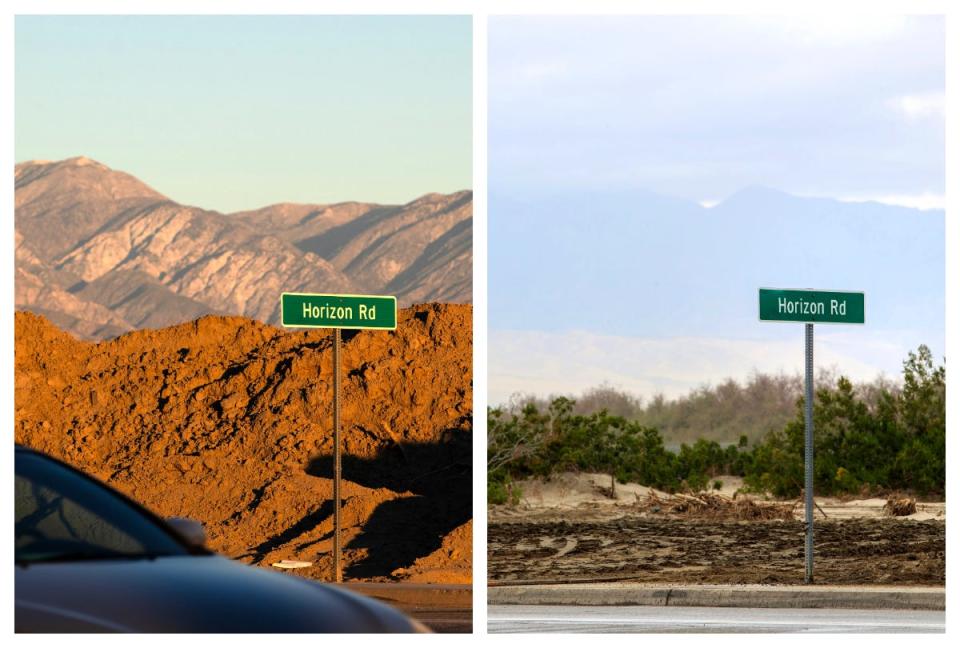
On that one night in August, Horizon Road had become unrecognizable. The northeast corner of the neighborhood is a high-risk flood zone, and many residents are used to it filling with water the few times a year there's significant rain in the Coachella Valley.
But nobody had expected the mud.
Several feet of it had flowed through the street, bursting through doors and invading homes as the storm's winds drove floodwaters through the valley. There was shock and then panic when people realized they were stuck inside. First responders were unable to reach many and had to prioritize by level of emergency. People were either forced to stay trapped inside for days, or rely on friends, family or neighbors to help them get out.
It was an unprecedented disaster. City officials are calling it a 1 in 1,000-year flood event. And even though it’s been several months since the storm, residents are still recovering.
Digging out the street
The days after the flood were focused on digging out the muck that had intruded into homes and covered the road. Piles and piles of it were stacked several feet high on empty lots in the neighborhood to get it out of the way.
Rick Ravanello, who has lived on Horizon Road for around nine years, said the pile across from his home was taller than the stop sign. The city is spending nearly $4 million to remove the heaps of dirt, which had taken residence along Date Palm Drive and Vista Chino and loomed over the community as a reminder of what happened there. It was nearly all gone last week, including the pile on Horizon Road.
The smell — a rancid mixture of damp wood, mud and sewage — has mostly cleared as the city resurfaced the road and people began reconstructing their homes. But a layer of dust continues to cover everything, making being outside particularly uncomfortable in the often-windy weather.
The extent of damages varied widely on the street. Some homeowners have to completely remodel, while others just had to repair their garages and/or landscaping.
Piecing things back together
Ravanello’s home was probably among the most damaged on the street. He left the doors open after the flood to prevent mold, though it still grew. The first floor was basically gutted, and the second floor and backyard also need repairs.
It’ll be around four more months before he and his wife Michelle can possibly move back home. The couple was living in a friend’s RV before their insurance provided them temporary housing.
“We’ll sort it out day by day,” Ravanello said.
He visits periodically to check on the construction progress with JCS Restoration, which is also working on neighbor Julie Burgess' home. Ravanello said he’s thankful to the company for helping with the overwhelming process.
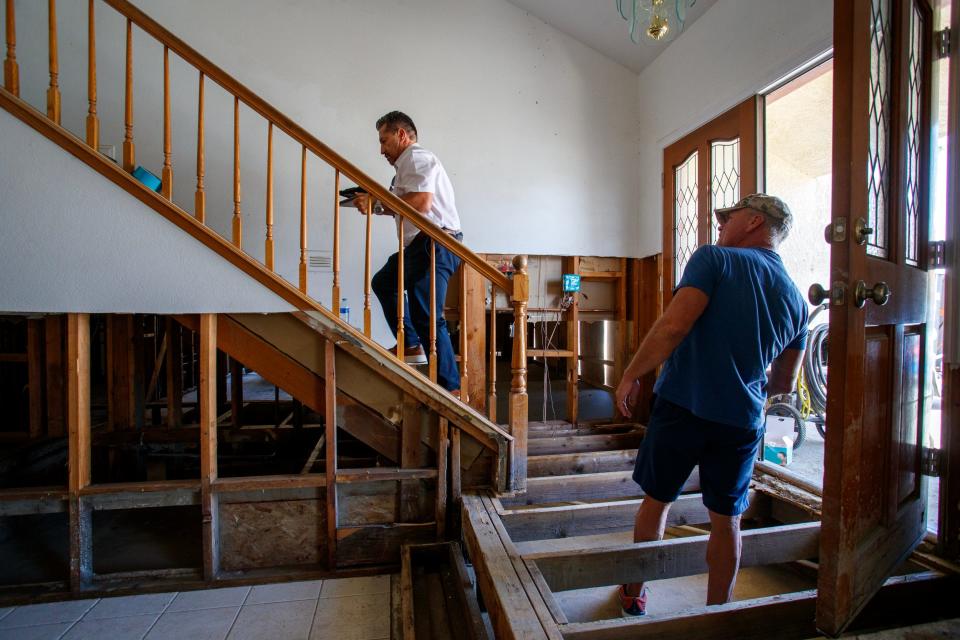
“You’re strung out on adrenaline and … you don't know how to cope because you don’t know where to start,” he said.
By last week, construction had reached the point where he can start picking out designs like the kind of flooring he wants. The fresh interior is a stark contrast to what it looked like in August, when there was around 3 feet of caked mud. Dirt was still inside the home until October, according to Ravanello.
Ravanello said it's going to cost over $60,000 to fix his backyard, which flood insurance won’t cover at all. On top of that, inside repairs will cost more than their insurance policy’s coverage limit, so they’ll use a loan to cover the rest.
“I look at (the home) and it’s not the same emotions anymore but, you know, you have emotions about the whole thing,” he said.
Elliott-Figueroa, a Horizon Road resident of 11 years, also had to remodel. About 2 feet of mud got into her one-story house, she said. Some necessary repairs include removing four feet of drywall, fixing the sliding doors, plumbing and electrical.
“Literally the whole house has to be completely redone, put back together,” Elliott-Figueroa said.
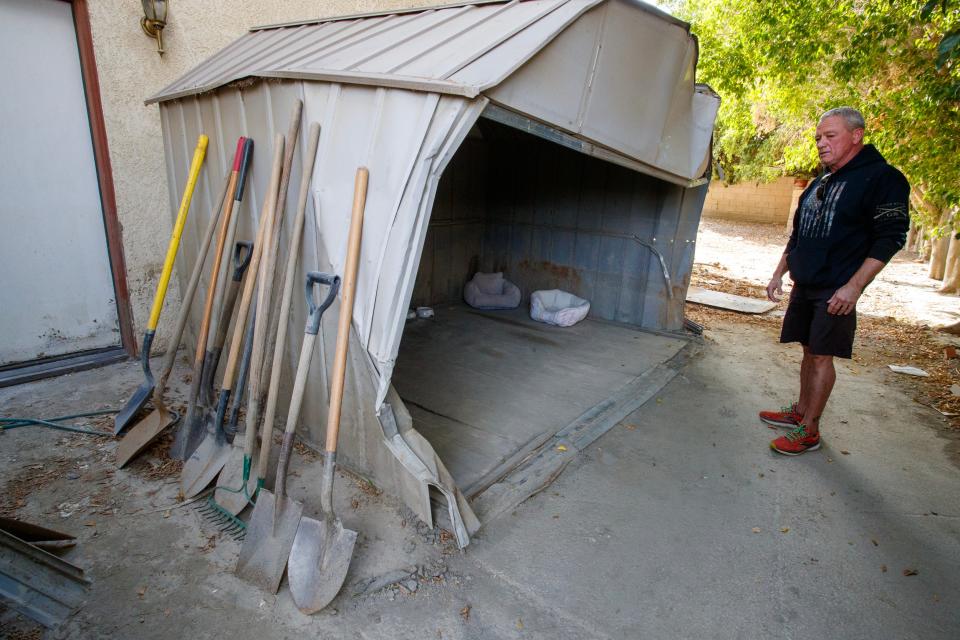
She said fixing their home is on her husband Frank Figueroa’s list of projects as a general contractor.
It will maybe be another two to three months before her family can move back in, but she’s still unsure how that will be possible. They’re staying in an Airbnb in Palm Desert in the meantime.
Their flood insurance is covering $250,000 for their home but won’t cover damages outside, she said. Elliott-Figueroa said they will eat through that amount easily due to exorbitant costs, and just removing the mud and water was at least $80,000.
“There’s so much to do and there’s so much that we did already,” she said.
An emotional toll
Burgess has lived on Horizon Road for six years. Something told her not to go to sleep when the storm came, she said. She fled upstairs, where her two young sons and their friend were, when mud burst into her home.
She said the entire downstairs of the home was damaged and they realistically won’t be able to move back in until around March or April. Her family is living in her grandmother’s condominium in Palm Springs after briefly living in a hotel and with her parents.
“Couldn’t stay at my parents’ house, that’s just too hard. They’re great, I love them. They’re not even there, but it's just like — that’s my childhood home. I was born and raised in that house,” Burgess said. “You don’t have your stuff and you’re living out of bins, and you need somewhere to go and unpack because you know you’re going to be here for at least six months.”
Her family coined the term “mud brain” to explain how the event has consumed their thoughts. She said her kids dream about it and talk about how they don’t want to move back home.
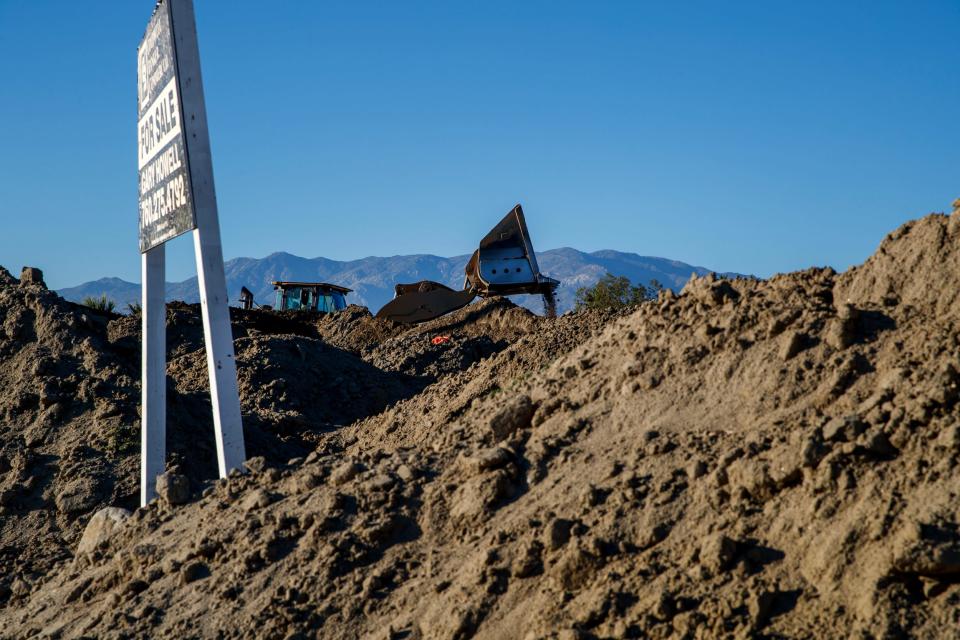
“The worst part about it all, (in the) aftermath, a solid two months every single night of a mud dream,” Burgess said. “Some way, somehow. Or smelling it even if you're out of town. Just embedded in your brain.”
Sonia Martin, who has lived on Horizon Road for around 8½ years, said she fixed the majority of the damage she got inside her house, but there are still little things that need to be repaired. She lived there through all the construction, which she described as "hectic."
"Mentally, we were like really going through it ... everyday we were kind of waking up, the same thing," she said. "So it took a toll on us, but I think we're starting to recover just a little bit now."
Martin works from home as an account manager. She said she was off for the first three or four days after the flood because there was mud underneath her desk. They couldn't leave their home those days either, she added.
"It's really depressing when you go down our street," Martin added. "It's really sad."
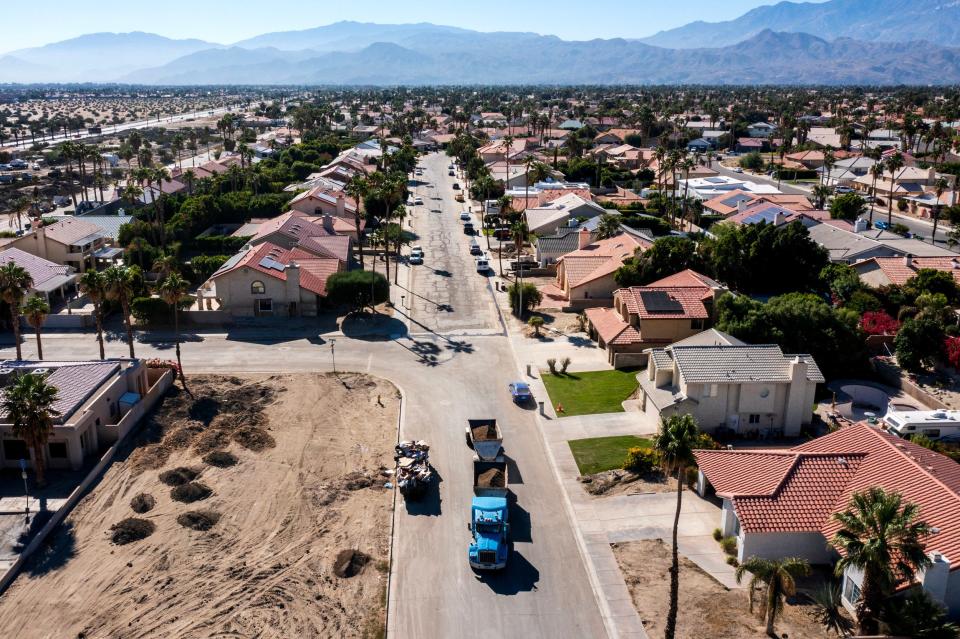
Elliott-Figueroa said she doesn’t like going back to see her house.
“It's just not a good feeling to be here, you know?” she said. “Like there’s a lot of trauma that came with just living through the event that happened and so it's just really hard.”
But the Airbnb she’s staying in doesn’t feel like home either. She told her husband they don’t realize how many things they don’t have anymore, since their Airbnb provides items like silverware, dishes and furniture. Their own furniture was damaged after floating in the mud.
“When we move, we have nothing. I mean, it was all gone,” Elliott-Figueroa said. “So … that, I think, is going to be another harsh reality that we're going to have to face once we're out of this Airbnb because for right now, we're just like, 'Oh, it's fine. We have, you know, some place to sit and a bed to sleep.’ It's not our bed. It’s not home.”
They also lost sentimental items like her children’s baby books, photo albums and family heirlooms.
“When I stay up at night having really bad thoughts, it's going back to ‘Those are the things that I lost.’ Because initially you’re in such shock, you’re not thinking about all of that really,” Elliott-Figueroa said. “But then when the dust settles and you’re really in it, you’re like 'Oh my goodness, I lost things that there’s no way I can ever get back.’ These are things I was saving for my children so they can have for their children and they’re irreplaceable.”
And the holidays will be particularly difficult this year. She said she’s used to hosting family gatherings, describing her place as the “fun house that everyone would come to.” They'll be hosting at their temporary home to make the most of the situation.
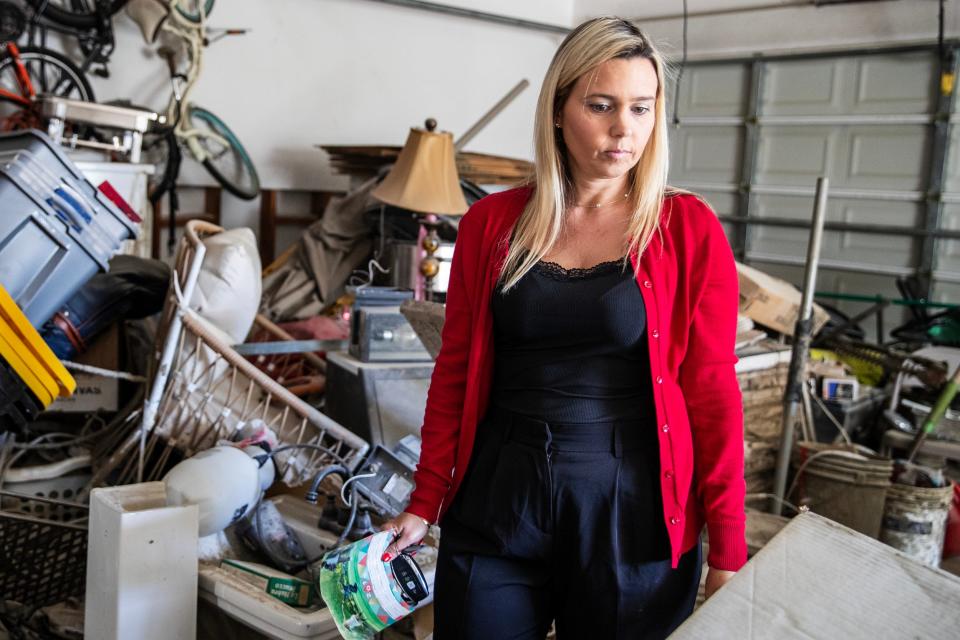
Stay or leave?
Several residents are anxious about whether a flood like this could devastate Horizon Road again. Many of them spoke out against the city during a city council meeting in September, demanding that it take action to prevent future disasters and better aid residents.
The city, for its part, is providing periodic updates during council meetings about the storm, including any aid it's applied for. President Joe Biden approved a disaster declaration for Riverside County and four other California counties on Tuesday, which will provide federal aid to help places impacted by the storm. The Coachella Valley Water District, which is the agency responsible for flood protection, is working on three projects in varying stages that would help prevent something similar from happening again.
City Manager Charlie McClendon said CVWD officials will attend the Nov. 29 city council meeting to address where the mud flows came from. He added that CVWD and the Riverside County Flood Control and Water Conservation District will also share updates about flood control projects.
But it remains to be seen how many residents will actually stick around. Michael Sereno said his partner, May Xu, is considering fixing their home and selling it in a year or two. They had moved in less than a year ago, according to Sereno.
“She’s kind of scared not knowing if they’re going to fix the problem if something happens again,” Sereno said.
The couple had to do major repairs, and have been sleeping on an air mattress at Xu’s spa at Hotel Zoso until they can move back in in about a month. Her insurance cut her payout by $30,000 because she incorrectly stated the property would be a rental, and it’s been frustrating to get the funds for construction, Sereno said.
Ray Brack, who lived on Vista Chino near the corner of Horizon Road for around 23 years, said he listed his home for sale about two days after the storm. It sold three days later for $330,000.
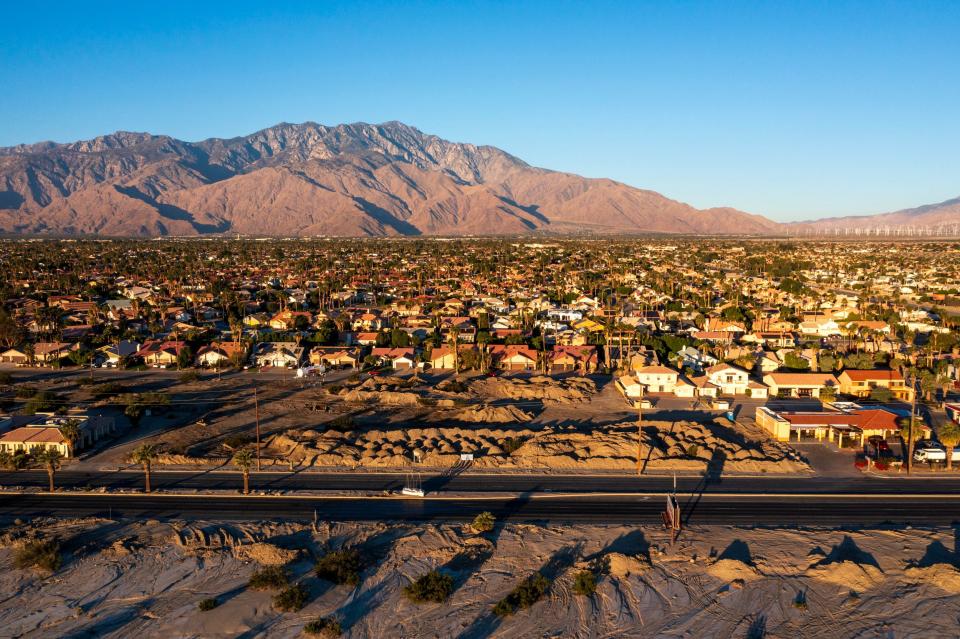
“I sealed the house up from another flood, so the mud couldn’t get in there. So the inside never got hardly anything in there, just water,” Brack said. “But there was like 4 feet of mud outside, 14 inches of the mud in the garage. My back patio windows looked like fish tanks.”
He said he decided to sell because he didn’t want to go through repairing from another flood and was tired of taking care of the house by himself anyway. Brack now lives in Palm Springs.
No home on Horizon Road appeared to be for sale as of last week. Residents like Ravanello have said they plan on staying.
“We’ve looked at other homes and stuff. But (my wife) loves this home (since) we first bought it and so do I,” Ravanello said.
Something beautiful on the horizon
In the wake of the storm, many residents have shared that they’re thankful that at least the neighborhood grew closer together.
“The great thing about this — neighbors that you knew and you saw daily now are friends,” Ravanello said. “It's like this little block’s become a family. I hope everybody stays.”
Michelle Ravanello owns the candle company Athena Candles, and lost some of her stock in the flood. But, her husband said, she started a special line just for neighbors with the label “Something beautiful is on the horizon.”
Elliott-Figueroa sees it the same way.
“I love our community and how everybody's coming together,” she said. “So I don't see how it can't come back and flourish, because everybody's working hard.”
Ani Gasparyan covers the western Coachella Valley cities of Desert Hot Springs and Cathedral City. Reach her at ani.gasparyan@desertsun.com.
This article originally appeared on Palm Springs Desert Sun: One Cathedral City neighborhood is still recovering from Hilary

